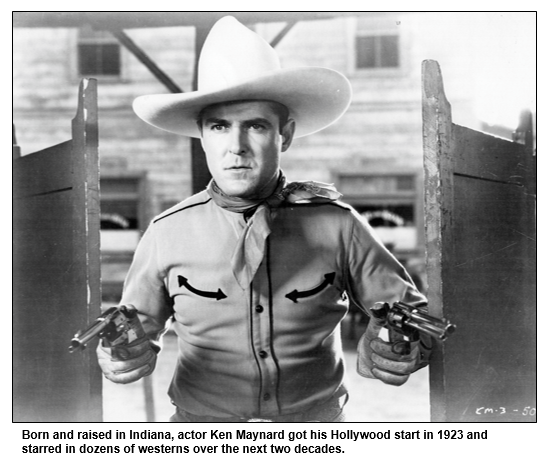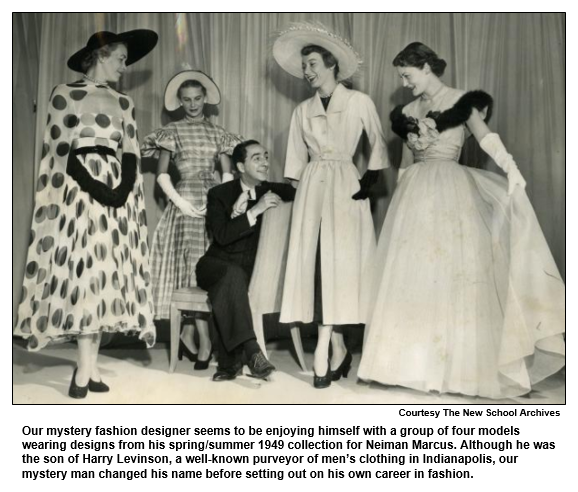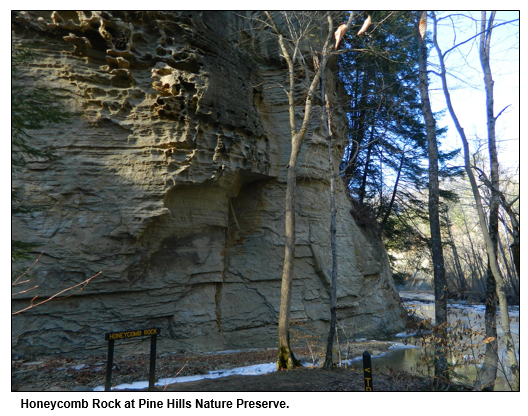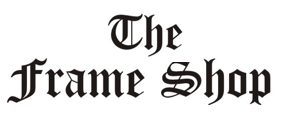Saturdays, noon to 1 p.m. ET on WICR 88.7 FM.
Or listen live from anywhere on WICR Online!
Our call-in number during the show: (317) 788-3314

Jan. 6, 2018
Cowboy actors and Trigger's owner: Indiana natives
To kick off the 10th year of Hoosier History Live, we will spotlight Indiana natives who had an impact on Western movies. Specifically, we will look at three Hoosier-born actors who portrayed cowboys during the early years of Hollywood. We're also champing at the bit to share facts about the Indiana connections of the most beloved horse in movie history.
Although Trigger is eternally associated with Roy Rogers, the breeder who initially owned and trained the famous horse grew up in Noblesville. Even before Roy Rogers mounted the golden stallion in movies and a long-running TV series, the horse - originally named Golden Cloud - was ridden by Olivia de Havilland (as Maid Marian) in the classic The Adventures of Robin Hood (1938).
Before Trigger rode into viewers' hearts as Rogers' faithful steed, three well-known stars of early Westerns had grown up in Indiana:
Buck Jones, the star of more than 60 movies, including Hearts and Spurs (1925), The Fighting Sheriff (1931) and The Cowboy and the Kid (1936), grew up in Vincennes. His name at his birth there in 1891 was Charles Frederick Gebhart.
- Ken Maynard, the hot-tempered star of such movies as The Canyon of Adventure (1928), was born in Vevay on the Ohio River (although studio publicity material incorrectly put his birthplace in Texas). He grew up in Columbus, Ind.
- And Allan "Rocky" Lane, whose movies included various serials for Republic Studios during the 1930s (including one about the Royal Canadian Mounted Police) and Bandit King of Texas (1949). Born in Mishawaka in 1909, Lane worked on a family farm as a boy.
To discuss the Hoosier roots of these actors and Trigger's owner, Noblesville native Roy Fletcher Cloud, Nelson will be joined by two studio guests.
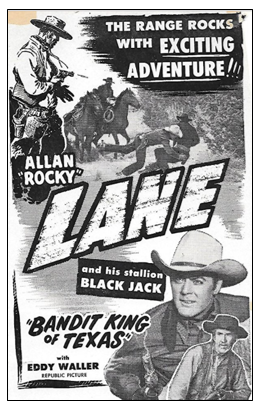
Hamilton County historian David Heighway has researched and written about Roy Cloud (1881-1940), who headed west around 1900 after growing up in Noblesville. In a blog post about Cloud that David Heighway wrote for the Hamilton East Public Library, where he works in collections services, he reports that Cloud managed a farm in southern California. Cloud purchased and trained the palomino stallion that later became nationally famous as Trigger.
Speaking of fame: In Hoosiers in Hollywood, David Smith describes Buck Jones as "the most beloved and idolized" of early Western stars, topped only by Tom Mix. Mix wasn't a Hoosier, but he had connections to Indiana that David Heighway will discuss during our show.
At the peak of his fame during the 1920s, Mix created a sensation when he visited Indianapolis, where he was greeted by the governor and mayor before dropping in to see patients at Riley Hospital for 
According to a blog post David Heighway has written, Otis Bart even loaned money to Tom Mix during their Wild West show days. An Indianapolis News account of the 1925 visit, which David includes in his blog post, describes Mix as one of the highest-paid Hollywood stars at the time, earning nearly $7,500 weekly.
In contrast, Ken Maynard apparently had a hard-scrabble youth in Columbus; according to Hoosiers in Hollywood, he even ran away briefly at age 12 with a traveling medicine show. In his teens, he toured with Wild West shows and a circus, perfecting a rope-twirling trick.

Buck Jones, though, is "fondly remembered as one of the most well-liked cowboy stars," David writes. "He was a kind and sincere person." According to reports, many cast and crew members of Jones' final film wept when they learned of his death in a nightclub fire in 1942.
History fact: Among the young actors who had small parts in Westerns of the 1930s starring Buck Jones was Marion Mitchell Morrison, known professionally as John Wayne.
History Mystery
In addition to being the origin of Trigger's original owner, Noblesville was the hometown of a top American fashion designer whose glamorous clients - beginning in the 1940s - included movie stars such as Marilyn Monroe, Lauren Bacall, Doris Day and Lena Horne. He was considered one of the first American fashion designers to become as revered in the world of haute couture as his counterparts in Europe.
He was born in Noblesville in 1900 and, as a boy, worked in his father's hat shop.
Hint: The designer was part of the Harry Levinson family that became well-known in Central Indiana as a retailer of men's clothing. But he changed his surname as a young man.
Question: Who was our mystery fashion designer?
The call-in number is (317) 788-3314. Please do not call in to the show until you hear Nelson pose the question on the air, and please do not try to win if you have won any other prize on WICR during the last two months. You must be willing to give your first name to our engineer, you must answer the question correctly on the air and you must be willing to give your mailing address to our engineer, so we can mail the prize pack to you. The prize is a gift certificate to Story Inn, courtesy of Story Inn; and a Family 4 Pack to the Indiana History Center, courtesy of the Indiana Historical Society.
Roadtripper: Pine Hills Nature Preserve
Michael Homoya of the Indiana Department of Natural Resources suggests a Roadtrip to Pine Hills Nature Preserve for an outstanding winter hiking experience and a spectacular walk atop the Devil’s Backbone.
Pine Hills, which is now a part of Shades State Park, offers rugged hills covered with scattered stands of evergreens mixed with hardwood trees. The area's white pine, hemlock and Canada yew trees are relics which have persisted since the period following the last glacier, when the climate was much colder.
Indiana's mountain-free landscape is not exactly known for inspiring excitement, but Pine Hills offers some of the most dramatic topography in the Hoosier state. Deep ravines, technically known as "incised meanders," cut through the hills and create steep-sided ridges, often called "backbones." As Michael explains, the ridges were formed by melting glacial water thousands of years ago and are recognized as some of the most remarkable examples of this type of geographic formation in the eastern United States.
If you decide to go walking on the Devil's Backbone, however, be careful! You'd have a devil of a time escaping serious injury from the 70-100 foot drop to the valley floor below!
Sponsorship opportunity: History Mystery prizes
Do you own a business or work for an organization that could use a marketing boost? Contributing prizes for our weekly History Mystery on-air giveaway can be a great way to spur interest among the educated, affluent listeners of Hoosier History Live. In exchange for your prize contribution, you get a linked reference to your organization in the History Mystery section of our website and weekly email newsletter, as well as a mention by Nelson on the live show.
If you are interested in contributing, contact molly@hoosierhistorylive.org for more details. The prize or voucher must be something that can be mailed in a regular business-size envelope and must also arrive in advance to our office before being offered in our newsletter. Tickets to dated performances are great, but must be offered well in advance.
Save the date! Hoosier History Live 10th Anniversary Party!
Mark your calendars for the Hoosier History Live 10th Anniversary Party. The annual soiree will take place on Thursday, March 1, from 5 to 7:30 pm at Indiana landmarks Center, 1201 N. Central Ave. Catering by MBP Distinctive Catering.
Nelson Price, host and historian
Molly Head, producer/project manager, (317) 927-9101
Michael Armbruster, associate producer
Cheryl Lamb, marketing and administrative manager
Richard Sullivan, senior tech consultant
Pam Fraizer, graphic designer
Garry Chilluffo, special events consultant
Please tell our sponsors that you appreciate their support!

 Acknowledgments to Monomedia, Visit Indy, WICR-FM, Fraizer Designs, Heritage Photo & Research Services, Henri Pensis, Chris Shoulders and many other individuals and organizations. We are an independently produced program and are self-supporting through organizational sponsorships and individual contributions. We do not receive any government funding. Visit our website to learn how you can support us financially. Also, see our Twitter feed and our Facebook page for regular updates.
Acknowledgments to Monomedia, Visit Indy, WICR-FM, Fraizer Designs, Heritage Photo & Research Services, Henri Pensis, Chris Shoulders and many other individuals and organizations. We are an independently produced program and are self-supporting through organizational sponsorships and individual contributions. We do not receive any government funding. Visit our website to learn how you can support us financially. Also, see our Twitter feed and our Facebook page for regular updates.
Thank you!
We'd like to thank the following recent, new and renewal contributors whose donations help make this show possible!
- Jo Ellen Meyers Sharp.
- Theresa and David Berghoff.
- Juliet Emanuel.
- Emerson Houck.
- James H. Madison.
- Tom Spalding.
Jan 13, 2018 - Upcoming
House of Tomorrow and other 1933 Chicago World's Fair homes
On the shores of Lake Michigan at the Indiana Dunes, five distinctive houses - including the legendary House of Tomorrow - are the focus of nearly as much public interest as the famous sand dunes. Designed as showplace houses for the 1933 Chicago World's Fair, the homes were brought by barge to the resort town of Beverly Shores, Ind., after the fair closed.
During the 80-plus years since arriving at their permanent location, the former exhibit houses - which include residences known as the Florida House and the Cyprus House - have had their share of ups and downs.
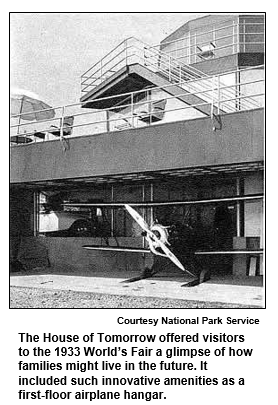
"In the midst of the Great Depression, the House of Tomorrow . . . offered millions a hopeful vision of a brighter, easier future," notes Indiana Preservation, a publication of Indiana Landmarks.
Perched on the Dunes, the five former exhibit houses are the only remaining structures from the 1933 Chicago World's Fair, which had a "Century of Progress" theme. Since the mid 1960s, the houses have been part of the Indiana Dunes National Lakeshore. Owned by the National Park Service, the houses are leased to Indiana Landmarks, the historic preservation organization. Landmarks, in turn, subleases them to tenants who agree to maintain them.
Four of the houses - including the pink Florida House, which has patios with sweeping views of Lake Michigan - are in good shape. But not the House of Tomorrow, which fell into shocking disrepair during the 1990s and is currently unoccupied. A $2.5 million fund-raising campaign is underway by Indiana Landmarks to finance the major restoration that is already in progress at the house. It no longer has an airplane hangar.
Todd Zeiger, director of Indiana Landmarks' northern regional office in South Bend, will be Nelson's studio guest to describe the colorful saga of the five distinctive homes in Beverly Shores.
At the 1933 Chicago World's Fair, 1.2 million people paid 10 cents apiece to tour the House of Tomorrow.
In 2016, the National Trust for Historic Preservation designated the house a "National Treasure," a label "reserved for significant structures in dire straits," according to a story in the Indianapolis Star. Because of their location on the Dunes, the houses take a beating from Mother Nature; wind, sand and the harsh winters of far-northern Indiana conspire to make preservation an on-going challenge.
© 2018 Hoosier History Live. All rights reserved.
|

